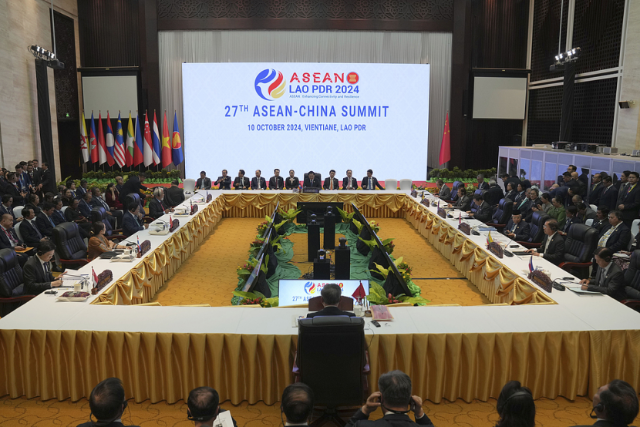
(Photo: CFP)
In the election year worldwide with drama and turbulence, half of ASEAN countries have undergone power transitions in 2024, namely, Singapore, Thailand, Cambodia, Vietnam, and Indonesia. The smooth political handovers have secured a promising future for ASEAN as a whole.
Stretching out an island-clustered land of about 4.49 million square kilometers, ASEAN member countries possess a population of 671.7 million. Given the acceleration of industrialization and digital transformation in recent years, the community has become one of the regions that enjoy high economic growth globally.
The average economic growth rate in ASEAN member states has been 4% to 5% over the past decade, and it has been the world's fifth-largest economy at present.
The World Economic Outlook released by the International Monetary Fund (IMF) in October this year forecasts that the GDP of Southeast Asian countries amounts to 3.98 trillion US dollars (current prices) with a real GDP growth of 4.6% on average.
At the country level, the economic growth of Vietnam, the Philippines, Cambodia, and Indonesia is expected to be outstanding in 2024, with 6.1%, 5.8%, 5.5%, and 5%, respectively, as the IMF predicts.
China has remained ASEAN's largest trading partner for 15 consecutive years. Correspondingly, ASEAN has been China's largest trading partner for four consecutive years since 2020.
Data from the General Administration of Customs of China, unveiled in the first 11 months of 2024, shows that the total trade value between China and ASEAN reached 6.29 trillion yuan with an increase of 8.6%, accounting for nearly 16% of China's total foreign trade.
Chinese exports to ASEAN countries were 3.74 trillion yuan, surging 12.7%, and imports from ASEAN were 2.55 trillion yuan with an increase of 3.0%. In US dollar terms, the total trade value between China and ASEAN reached approximately US$885 billion, with an increase of 7.2%.
Exports were US$526.66 billion, soaring 11.2%, and imports were US$358.60 billion, rising 1.8%. Among ASEAN members, Vietnam, Malaysia, and Indonesia rank as China's top three trading partners.

Leaders attend the 27th Association of Southeast Asian Nations (ASEAN)-China Summit in Vientiane, Laos, Thursday, Oct. 10, 2024. (Photo: CFP)
Notably, earlier in October this year, leaders from China and ASEAN gathered at the sidelines of the 27th China-ASEAN Summit in Vientiane, Laos, under the chairmanship of ASEAN in 2024. They announced the substantial conclusion of ASEAN-China Free Trade Area (ACFTA) 3.0 Upgrade Negotiations.
The ACFTA 3.0 covers nine areas, including both existing areas of the China-ASEAN Free Trade Agreement such as Customs Procedures and Trade Facilitation, Standards, Technical Regulations, and Conformity Assessment Procedures, Sanitary and Phytosanitary measures, and Economic and Technical Cooperation.
The upgraded FTA will also take emerging domains with new opportunities for collaboration between the two sides into consideration, namely, the Digital Economy, Green Economy, Supply Chain Connectivity, Competition and Consumer Protection, and Micro-, Small and Medium-sized Enterprises (MSMEs).
The negotiation teams of both sides have formulated a work plan before the signing of the 3.0 version of the upgraded protocol. It will speed up the completion of subsequent work such as the upgraded protocol's formulation, legal review of the text, and implementation of domestic procedures in preparation for the signing of the agreement next year.
Reciprocity is the golden rule of international relations. The year 2024 has witnessed the 50th anniversary of China and Malaysia establishing diplomatic ties. Political, economic, and cultural exchanges along with tourism—all facets of cooperation—have been laid out and accomplished throughout the year.
Next year, half of ASEAN member countries will embrace such celebrations, with Vietnam, Indonesia, and Myanmar marking their 75th anniversary, Thailand and the Philippines celebrating their 50th, as well as Singapore observing its 35th.
Given the comparative advantage of geography, bestowed cultural proximity, and frequent economic exchanges, the Guangdong–Hong Kong–Macao Greater Bay Area (GBA) should embrace its neighbors—ASEAN countries—unleash its potential to further work with this thriving community to formulate a holistic and inclusive development roadmap. Only in this way can the two demonstrate goodwill and prosperity for the approaching new year.
Author: Zhang Ruijun
Editor: Yuan Zixiang, James, Shen He
















